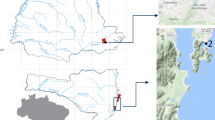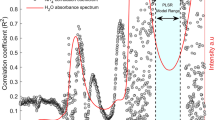Abstract
Large-scale use of chemical fertilizers has resulted in the contamination of agricultural runoff waters by soil macronutrients NPK, whose detection is of significant interest. This work reports the determination of macronutrients in the form of urea (N), orthophosphate PO43- (P), and potassium K+ (K) in simulated agricultural runoff waters. Their solutions were prepared by extracting water-soluble constituents of soil. This ‘base’ solution contains high concentrations of various species, including Cl-, SO42-, NO3-, PO43-, Na+, K+, and NH4+ along with natural organic matter. Predetermined amounts of urea (4 to 22.5 ppm), PO43- (7 to 50 ppm), and potassium K+ (25 to 250 ppm) were added to the base simulated runoff water to prepare standard stock solutions. Using stainless steel working and counter electrodes, a small AC perturbation (±10 mV vs. OCP, vs. Ag/AgCl) was applied and the frequency response of the working electrode-solution interface was measured from 1 Hz to 1 MHz. The interface itself was modeled as a suitable equivalent electrical circuit, and the magnitudes of its components were fitted from experimental data using nonlinear regression. It is observed that PO43- concentration is a linear function of charge transfer resistance arising from redox reaction, K+ concentration is a quadratic function of double-layer capacitance arising from its higher mobility, and urea concentration can be correlated as a linear function of constant phase element arising from its polarization in the presence of an applied electric field. The sensor exhibits good sensitivity, repeatability, and excellent performance against interfering species. These preliminary results show significant potential for development of a real-time or on-site sensing device.





Similar content being viewed by others
Data availability
All data and materials pertaining to the study are available with the corresponding author Murali Rangarajan and the two equal-contribution first authors Guruprasadh Jagannathan Parasuraman and Ramakrishnan Vishnuraj.
References
Agrawal GD (1999) Diffuse agricultural water pollution in India. Water Sci Technol 39:33–47. https://doi.org/10.1016/S0273-1223(99)00030-X
An D, Yang L, Liu B et al (2017) Diffusion performance of fertilizer nutrient through polymer latex film. J Agric Food Chem 65:10868–10874. https://doi.org/10.1021/acs.jafc.7b04225
Bhandari S, Singh U, Kumbhat S (2019) Nafion-modified carbon-based sensor for soil potassium detection. Electroanalysis 31:813–819. https://doi.org/10.1002/elan.201800583
Bogard MJ, Donald DB, Finlay K, Leavitt PR (2012) Distribution and regulation of urea in lakes of central North America. Freshw Biol 57:1277–1292. https://doi.org/10.1111/j.1365-2427.2012.02775.x
Caron W-O, Lamhamedi MS, Viens J, Messaddeq Y (2016) Practical application of electrochemical nitrate sensor under laboratory and forest nursery conditions. Sensors (Switzerland) 16:1190. https://doi.org/10.3390/s16081190
Cesiulis H, Tsyntsaru N, Ramanavičius A, Ragoisha G (2016) The study of thin films by electrochemical impedance spectroscopy. In: Tiginyanu I, Topala P, Uraski V (eds) Nanostructures and thin films for multifunctional applications. Springer International Publishing, Switzerland, pp 3–42
Chaudhari PR, Ahire DV, Ahire VD et al (2013) Soil bulk density as related to soil texture, organic matter content and available total nutrients of Coimbatore soil. Int J Sci Res Publ 3:2250–3153 https://www.ijsrp.org/research-paper-0213/ijsrp-p1439.pdf. Accessed 31 Aug 2021
Chris Sheba M, Devaki R, Uma RN (2019) Case study on the soil physical parameters disparity and NPK concentrations in regions found in and around Pachapalayam, Coimbatore, Tamil Nadu. IOP Conf Ser: Mater Sci Eng 705:012052. https://doi.org/10.1088/1757-899X/705/1/012052
Cinti S, Talarico D, Palleschi G et al (2016) Novel reagentless paper-based screen-printed electrochemical sensor to detect phosphate. Anal Chim Acta 919:78–84. https://doi.org/10.1016/j.aca.2016.03.011
Copes WE, Zhang H, Richardson PA et al (2017) Nutrient, pH, alkalinity, and ionic property levels in runoff containment basins in Alabama, Louisiana, Maryland, Mississippi, and Virginia ornamental plant nurseries. Hort Sci 52:641–648. https://doi.org/10.21273/HORTSCI11647-16
Davis AM, Tink M, Rohde K, Brodie JE (2016) Urea contributions to dissolved ‘organic’ nitrogen losses from intensive, fertilised agriculture. Agric Ecosyst Environ 223:190–196. https://doi.org/10.1016/j.agee.2016.03.006
Day C, Søpstad S, Ma H et al (2018) Impedance-based sensor for potassium ions. Anal Chim Acta 1034:39–45. https://doi.org/10.1016/j.aca.2018.06.044
Diba FS, Lee HJ (2016) Amperometric sensing of sodium, calcium and potassium in biological fluids using a microhole supported liquid/gel interface. J Electroanal Chem 769:5–10. https://doi.org/10.1016/j.jelechem.2016.02.045
Finlay K, Patoine A, Donald DB et al (2010) Experimental evidence that pollution with urea can degrade water quality in phosphorus-rich lakes of the Northern Great Plains. Limnol Oceanogr 55:1213–1230. https://doi.org/10.4319/lo.2010.55.3.1213
Food and Agricultural Organization (2022) India at a Glance In: Food and Agricultural Organization of the United Nations. https://www.fao.org/india/fao-in-india/india-at-a-glance/en/. Accessed 30 Apr 2022
Ghaffari SA, Caron W-O, Loubier M et al (2015) A wireless platform for electrochemical impedance spectroscopy. Sensors (Switzerland) 15:23572–23588. https://doi.org/10.3390/s150923572
Guruprasadh JP, Harshananda A, Keerthana IK et al (2017) Intelligent soil quality monitoring system for judicious irrigation. In: In: International Conference on Advances in Computing, Communications and Informatics (ICACCI). IEEE Xplore, Udupi. https://doi.org/10.1109/ICACCI.2017.8125880
Khan SUM, Liu G (1989) The effect of glucose on electroreduction of phosphate at a Pt electrode: an indirect method of glucose detection in KRPB solution. J Electroanal Chem Interfacial Electrochem 270:237–252. https://doi.org/10.1016/0022-0728(89)85039-9
Koneshan S, Rasaiah JC, Lynden-Bell RM, Lee SH (1998) Solvent structure, dynamics, and ion mobility in aqueous solutions at 25°C. J Phys Chem B 102:4193–4204. https://doi.org/10.1021/jp980642x
Li XF, Chen ZB, Chen HB, Chen ZQ (2011) Spatial distribution of soil nutrients and their response to land use in eroded area of South China. Procedia Environ Sci 10:14–19. https://doi.org/10.1016/j.proenv.2011.09.004
Li H, Xiao Y, Jin L (2020) Recent development of wearable electrochemical sensors for sweat analysis. Int J Electrochem Sci 15:11997–12006. https://doi.org/10.20964/2020.12.22
Liu Y-L, Liu R, Qin Y et al (2018) Flexible electrochemical urea sensor based on surface molecularly imprinted nanotubes for detection of human sweat. Anal Chem 90:13081–13087. https://doi.org/10.1021/acs.analchem.8b04223
Massah J, Azadegan B (2016) Effect of chemical fertilizers on soil compaction and degradation. AMA-Agr Mech Asia Afr 47:44–50
Özbek O, Berkel C, Isildak Ö, Isildak I (2022) Potentiometric urea biosensors. Clin Chim Acta 524:154–163. https://doi.org/10.1016/j.cca.2021.11.011
Parsaee Z (2018) Synthesis of novel amperometric urea-sensor using hybrid synthesized NiO- NPs/GO modified GCE in aqueous solution of cetrimonium bromide. Ultrason Sonochem 44:120–128. https://doi.org/10.1016/j.ultsonch.2018.02.021
Pawar CT, Pujari AA (2000) Soil degradation in sugarcane farming: a microlevel analysis. Trans Inst Indian Geogr 22:25–34
Rahman MT, Kabir MF, Qiao Q (2018) Electrochemical phosphate sensors using silver nanowires treated screen printed electrodes. In: In: 2018 IEEE International Conference on Electro/Information Technology. IEEE Explore, Rochester. https://doi.org/10.1109/EIT.2018.8500195
Reza SK, Ray P, Ramachandran S et al (2019) Spatial distribution of soil nitrogen, phosphorus and potassium contents and stocks in humid subtropical North-Eastern India. J Indian Soc Soil Sci 67:12–20. https://doi.org/10.5958/0974-0228.2019.00002.1
Rodríguez AR, González Soto MC, Hernández LA et al (1993) Assessment of soil degradation in the Canary Islands (Spain). Land Degrad Dev 4:11–20. https://doi.org/10.1002/ldr.3400040103
Souto RM, Laz MM, González S (1997) Kinetics and mechanism of the electroreduction of anodic layers produced on copper in phosphate containing aqueous solutions. Anales de Química Int Ed 93:252–259
Standing Committee on Agriculture. (2015-2016) Impact of chemical fertilizers and pesticides on agriculture and allied sectors in the country. 29th Report by Standing Committee on Agriculture, Government of India. http://www.indiaenvironmentportal.org.in/content/433891/impact-of-chemical-fertilizers-and-pesticides-on-agriculture-and-allied-sectors-in-the-country-standing-committee-on-agriculture-2015-2016/. Accessed 16 Jan 2019
Syers JK (1997) Managing soils for long-term productivity. Philos Trans R Soc Lond B 352:1011–1021. https://doi.org/10.1098/rstb.1997.0079
Taboada-Castro MM, Diéguez-Villar A, Taboada-Castro MT (2004) Transfer of nutrients and major ions of an agricultural catchment to runoff waters: analysis of their spatial distribution. ISCO 2004 - 13th International Soil Conservation Organisation Conference - Brisbane. https://www.tucson.ars.ag.gov/isco/isco13/PAPERS%20R-Z/TABOADA%202.pdf. Accessed 29 Apr 2022
Torrinha Á, Morais S (2021) Electrochemical (bio) sensors based on carbon cloth and carbon paper: An overview. Trends Anal Chem 142:116324. https://doi.org/10.1016/j.trac.2021.116324
Uddameri V, Singaraju S, Hernandez EA (2018) Detecting seasonal and cyclical trends in agricultural runoff water quality—hypothesis tests and block bootstrap power analysis. Environ Monit Assess 190:157. https://doi.org/10.1007/s10661-018-6476-y
Umar L, Setiadi RN (2015) Low cost soil sensor based on impedance spectroscopy for in-situ measurement. AIP Conf Proc 1656:04005. https://doi.org/10.1063/1.4917112
Valiūnienė A, Virbickas P, Medvikytė G, Ramanavičius A (2020) Urea biosensor based on electrochromic properties of Prussian blue. Electroanalysis 32:503–509. https://doi.org/10.1002/elan.201900556
Valiūnienė A, Kavaliauskaitė G, Virbickas P, Ramanavičius A (2021) Prussian blue based impedimetric urea biosensor. J Electroanal Chem 895:115473. https://doi.org/10.1016/j.jelechem.2021.115473
Wang D, Yan W, Vijapur SH, Botte GG (2012) Enhanced electrocatalytic oxidation of urea based on nickel hydroxide nanoribbons. J Power Sources 217:498–502. https://doi.org/10.1016/j.jpowsour.2012.06.029
Xu J, Gao Z, Dou X, Song Y-Y (2021) Needle-like Co3O4 nanoarrays as a dual-responsive amperometric sensor for enzyme-free detection of glucose and phosphate anion. J Electroanal Chem 897:115605. https://doi.org/10.1016/j.jelechem.2021.115605
Funding
The authors acknowledge funding from Amrita Vishwa Vidyapeetham. Murali Rangarajan acknowledges financial support from Science and Engineering Research Board (SERB) through the core research grant (EMR/2017/000116), Ministry of Human Resource Development (MHRD) through the FAST grant (F. No. 5-6/2013-TS.VII), and Department of Science and Technology (DST) through the FIST grant (SR/FST/ETI-416/2016), for the conduct of this research.
Author information
Authors and Affiliations
Contributions
The study was conceived and designed by Murali Rangarajan. Guruprasadh Jagannathan Parasuraman and Ramakrishnan Vishnuraj contributed equally to material preparation, data collection and analysis, and the writing of the first two drafts of the manuscript as well as graphical/tabular presentations of the results. Surjith Kannankuzhiyil, Mohankumar Govindaraj, and Sabarinath Sasikumar Biji prepared the materials, performed various experiments and collected data. Surjith Kannankuzhiyil and Mohankumar Govindaraj also contributed to data analysis. Murali Rangarajan prepared the final version of the manuscript. All authors read and approved the final manuscript.
Corresponding author
Ethics declarations
Ethical approval
Not applicable
Consent to participate
Not applicable
Consent to publish
Not applicable
Competing interests
The authors declare no competing interests.
Additional information
Responsible Editor: Weiming Zhang
Publisher’s note
Springer Nature remains neutral with regard to jurisdictional claims in published maps and institutional affiliations.
Supplementary Information
ESM 1
(DOCX 393 kb)
Rights and permissions
Springer Nature or its licensor holds exclusive rights to this article under a publishing agreement with the author(s) or other rightsholder(s); author self-archiving of the accepted manuscript version of this article is solely governed by the terms of such publishing agreement and applicable law.
About this article
Cite this article
Parasuraman, G.J., Vishnuraj, R., Kannankuzhiyil, S. et al. Determination of urea, phosphate, and potassium in agricultural runoff waters using electrochemical impedance spectroscopy. Environ Sci Pollut Res 30, 98858–98868 (2023). https://doi.org/10.1007/s11356-022-22369-2
Received:
Accepted:
Published:
Issue Date:
DOI: https://doi.org/10.1007/s11356-022-22369-2




